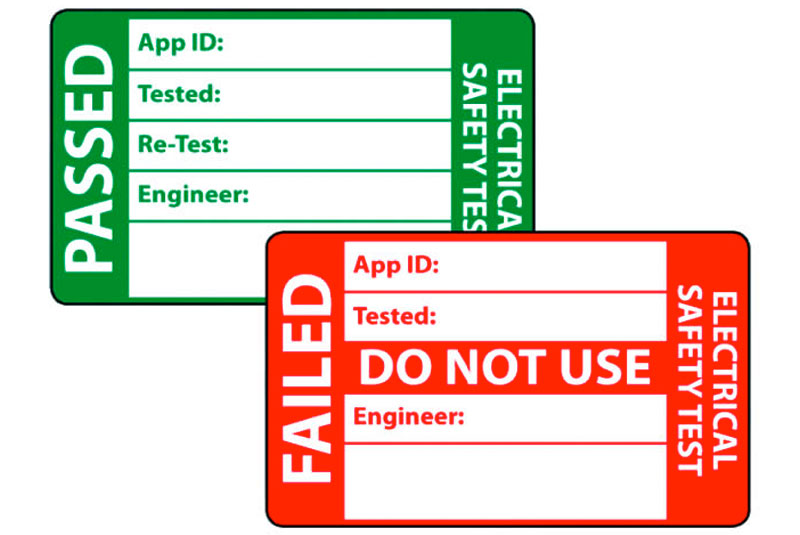Portable appliance testing (PAT) is the term used to describe the examination of electrical appliances and equipment to ensure they are safe to use. Most electrical safety defects can be found by visual examination, but some types of defects can only be found by testing. A portable Appliance Test is a combination of Visual and Testing to ascertain the continued electrical safety of an electrical appliance.
A relatively brief user check (based upon simple training and perhaps assisted using a brief checklist) can be a very useful part of any electrical maintenance regime. However, more formal visual inspection and testing by a competent person may also be required at appropriate intervals, depending upon the type of equipment and the environment in which it is used.
The Electricity at Work Regulations 1989 require that any electrical equipment that has the potential to cause injury is maintained in a safe condition. However, the Regulations do not specify what needs to be done, by whom or how frequently (ie they don’t make inspection or testing of electrical appliances a legal requirement, nor do they make it a legal requirement to undertake this annually)
The frequency of inspection and testing depends upon the type of equipment and the environment it is used in. For example, a power tool used on a construction site should be examined more frequently than a desktop PC, due to the conditions in which the equipment is used. Static equipment, with little disturbance to its power supply and housing, is less likely to become damaged than a site-based power tool, used in different arduous conditions, requiring multiple disconnection from power supplies where the risk of damage to the cables, sockets and equipment housing in significantly increased.
There is no legal requirement to label equipment that has been inspected or tested, nor is there a requirement to keep records of these activities. However, it is considered good practice to produce and keep record and / or labelling can be a useful management tool for monitoring and reviewing the effectiveness of the maintenance scheme – and to demonstrate that a scheme exists.
New equipment should be supplied in a safe condition and not require a formal portable appliance inspection or test. However, a simple visual check is recommended to verify the item is not damaged after which the item should be included in your ongoing regular maintenance regime.
The person doing testing work needs to competent to do it. In many low-risk environments, a sensible (competent) member of staff can undertake visual inspections if they have enough knowledge and training. However, when undertaking combined inspection and testing, a greater level of knowledge and experience is needed, and the person will need:
- the right equipment to do the tests.
- the ability to use this test equipment properly.
- the ability to properly understand the test results.
Effective maintenance of portable electric equipment can be achieved by a combination of:
- checks by the user;
- formal visual inspections by a competent person;
- where necessary a combined inspection and test, also known as a portable appliance test (PAT), by an electrically competent person.
The aim of these checks is to determine whether the equipment is fully serviceable or whether remedial action is necessary to make sure it is safe to use. 37 Managers should follow up these procedures by monitoring the effectiveness of the system and acting where faults are found, particularly when faults are frequent.
The person using the equipment should be encouraged to look at it before use and check for signs that it may not be in sound condition:
- damage (apart from light scuffing) to the supply cable, including fraying or cuts;
- damage to the plug or connector, e.g. the casing is cracking or the pins are bent;
- inadequate joints, including taped joints in the cable;
- the outer sheath of the cable is not effectively secured where it enters the plug or the equipment. Evidence would be if the coloured insulation of the internal cable cores were showing;
- the equipment has been subjected to conditions for which it is not suitable, e.g. it is wet or excessively contaminated;
- damage to the external casing of the equipment;
- loose parts or screws;
- evidence of overheating (burn marks or discolouration). 39 These checks also apply to extension leads, plugs and sockets.
A user check should be made when the equipment is taken into use and during use. Any faults should be reported to the relevant manager and the equipment taken out of use immediately. Managers should take effective steps to ensure that the equipment is not used again until it is repaired by a person competent to carry out the task (e.g. the defective equipment could be labelled as ‘faulty’ and if it has a rewireable plug this could be removed).
The checks and inspections outlined should reveal most potentially dangerous faults. However, some faults, such as loss of earth integrity (eg broken earth wire within a flexible cable), deterioration of insulation integrity, or contamination of internal and external surfaces, cannot be detected by visual examination alone. Such faults can only be reliably detected by a combined visual inspection and test. This should be carried out periodically to back up the checks and inspections and is likely to be justified:
- whenever there is reason to suppose the equipment may be defective and this cannot be confirmed by visual examination;
- after any repair, modification or similar work; or
- at periods appropriate to the equipment, the manner and frequency of use and the environment. 48 The inspection carried out in conjunction with testing should usually include checking:
- the correct polarity of supply cables;
- the correct fusing;
- effective termination of cables and cores;
- that the equipment is suitable for its environment.
Combined inspection and testing requires a greater degree of competence (in terms of knowledge, training and experience) than for inspection alone, because appropriate electrical knowledge is needed to undertake the tests and interpret the test results. However, it can often be carried out by a competent employee.
People testing portable electrical equipment should be appropriately trained. It is the employer’s duty to make sure that they are competent for the work they are to carry out
There are two levels of competency:
- Level 1: A person not skilled in electrical work routinely uses a simple ‘pass/fail’ type of portable appliance tester where no interpretation of readings is necessary. The person would need to know how to use the test equipment correctly. Providing the appropriate test procedures are rigorously followed and acceptance criteria are clearly defined, this routine can be straightforward.
- Level 2: A person with appropriate electrical skills uses a more sophisticated instrument that gives readings requiring interpretation. Such a person would need to be competent through technical knowledge or experience related to this type of work. 51 Some combination of the actions in paragraphs 38–46 should ensure, so far as reasonably practicable, that equipment will be maintained in a safe condition wherever it is used. The more extensive inspection and testing described in paragraphs 47–50 can be carried out less frequently if the maintenance system includes formal visual inspections and monitoring of the user checks.











